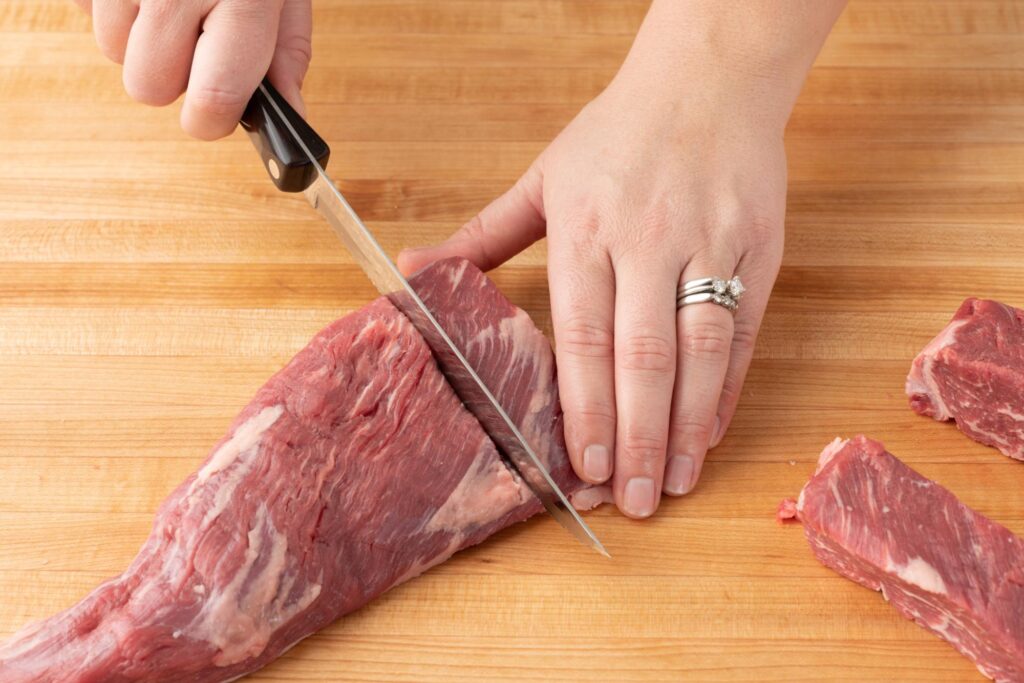Kitchen knives serve varied roles. Butcher knives are examples. Butcher knives are for what? This tutorial covers the many culinary uses of a butcher knife.
Knowing how to wield a butcher knife can improve your cuisine, whether you’re a pro or a home cook. Let’s explore this crucial kitchen gadget.
What Is a Butcher Knife Used For?
Butcher knives, often called cleavers, have wide blades and sharp cutting edges. It cuts, trims, and prepares meat. Butcher knives are ideal for many cooking tasks due to their length and weight. Let’s examine butcher knives’ many uses.
Breaking Down Large Cuts of Meat
Meat cleavers cut large meat portions into smaller, easier-to-handle bits. The extended and strong blade of a meat cleaver allows you to divide an entire chicken, beef tenderloin, or hog shoulder. Accurate incisions let you divide the meat to your liking.
Trimming Fat and Preparing Meat

Many recipes require meat trimming. Butcher knives simplify and improve this process. The knife’s length lets you cut through extra fat and connective tissue. A butcher knife can also remove silverskin, tendons, and other unpleasant parts before cooking.
Chopping and Dicing
Butcher knives may also cut and dice vegetables, herbs, and fruits. Its wide blade lets you quickly gather and transfer items to a chopping board. A butcher knife can slice onions, dice bell peppers, and mince garlic.
Slicing Through Tough Ingredients
Sometimes you need a strong blade to cut through stubborn materials. A butcher knife cuts through winter squash, melons, and large root vegetables. The blade’s weight and sharp edge allow downward pressure for clean, precise cuts without force.
Crushing Garlic and Smashing Ingredients

Butcher knives are useful for chopping, smashing garlic cloves, and mashing whole spices and herbs.
The large blade surface allows you to place the ingredient on a cutting board and apply force downwards to fragment it and release its aromatic essences. In recipes that require smashed garlic or spices, this method enhances flavor.
Carving Roasts and Poultry
A butcher knife is a chef’s best friend when carving roasts and fowl. This cooking tool’s extended and sharp-edged blade ensures perfectly sliced meat. A butcher knife’s adaptability and precision make carving a Thanksgiving turkey or slicing a prime rib for a special occasion easier.
Splitting Bones
In some recipes, bones must be split to get at the marrow or remove the meat. Butcher knives are ideal for this work due to their strong structure and sharp edge. Splitting bones easily speeds up cooking and enhances the flavor of your delicious dishes.
Creating Beautiful Presentation
Besides being utilitarian, a butcher knife may make your dishes seem better. Its impressive size and exquisite craftsmanship make it a clever display tool. A butcher knife adds sophistication to a charcuterie buffet, steak dish, or roast.
Maintaining a Butcher Knife

Proper butcher knife maintenance ensures durability and performance. Knife care:
Regular Cleaning: Wash and dry the knife after each use to prevent rust.
Sharpening: Use a sharpening stone or honing rod to keep your butcher knife sharp and effective.
Storage: Keep your butcher knife in a knife block or sheath to protect the blade and ensure safety when retrieving or storing it.
Avoid Dishwashers: Harsh detergents and high heat can destroy butcher knife blades and handles.
Choosing the Right Butcher Knife

To choose the right butcher knife, consider the following:
Blade length: Butcher knives are 6–12 inches long. Select a blade length that matches your tastes and the meat cuts you use.
Blade Material: High-carbon stainless steel, which resists staining and corrosion, is preferred for butcher knives.
Comfort: Choose a butcher knife with an ergonomic handle to avoid hand fatigue.
Weight: Weigh the knife. Some chefs like a heavier knife for stability, while others prefer a lighter one for agility.
Common Questions
Can I use a butcher knife for other things?
Butcher knives can be used for more than just meat prep. It can chop vegetables, mince herbs, and shatter items.
However, a butcher knife’s heft and weight may make it unsuitable for precise slicing or peeling. For best results, use a specialty knife.
Sharpen my butcher knife how often?
Depends on usage and blade quality. Sharpen your knife every few months or when its cutting performance decreases. Regular sharpening with a rod helps maintain the
Can novice cooks use a butcher knife?
Beginners can use butcher knives with caution and proper handling. Beginners should start with simpler cutting and slicing chores because to its increased size and weight. Beginners should practice knife skills and safety with any knife.
Dishwasher-safe butcher knives?
Handwash and dry butcher knives after use, even if they’re dishwasher safe. Dishwashers use harsh detergents and high heat, which can harm knife blades, handles, and quality. Handwashing is best for butcher knives.
Conclusion
In conclusion, a butcher knife is an indispensable culinary tool for breaking down huge portions of meat, cutting fat, chopping, slicing, and carving. Professional chefs and family cooks trust its strong build, sharp blade, and comfortable grip.
You may maximize a butcher knife’s potential and improve your cooking by learning its functions and following safety and maintenance guidelines.
Always prioritize safety, sharpen regularly, and use the correct butcher knife for the job. A butcher knife can help you attain precision, efficiency, and spectacular culinary outcomes if handled properly.
